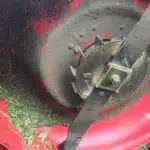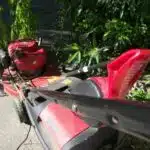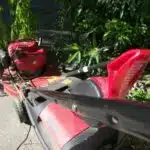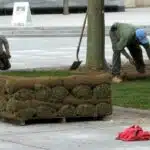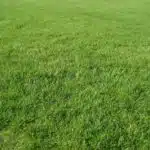Mowing a lawn is an essential task in maintaining the health and beauty of your outdoor space. Whether you have a small front yard or a sprawling estate, proper mowing techniques are crucial for promoting healthy turf growth and preventing damage to your lawn. As a landscaping expert, I am passionate about helping individuals achieve their dream outdoor spaces through education and practical tips.
A well-maintained lawn is not only aesthetically pleasing but also provides numerous benefits such as improving air quality, reducing erosion, and providing a safe place for children and pets to play. However, without proper mowing techniques, your lawn can quickly become stressed, leading to discoloration, thinning, and even disease. In this article, we will explore the best practices for mowing your lawn that will not only enhance its overall appearance but also improve its health and longevity. So sit back, grab a cold drink, and let’s dive into the world of lawn care!
Understanding Your Lawn’s Needs
A well-manicured lawn requires more than just regular mowing. To have a lush and healthy lawn, you need to understand its needs. This starts with conducting a thorough analysis of your lawn’s condition. Consider the type of grass, soil quality, and any existing issues such as pests or diseases.
One crucial aspect of understanding your lawn is through soil testing. Soil testing will provide valuable information on the nutrient levels in your soil, pH balance, and other factors that may affect the health of your grass. With this knowledge, you can make informed decisions about fertilization, watering, and other maintenance tasks that will promote healthy growth.
In addition to soil testing, it’s essential to assess other factors such as sun exposure and drainage. Does your yard receive enough sunlight? Is there proper drainage to prevent waterlogging? These considerations will help determine the best course of action for maintaining a beautiful lawn. Next up is choosing the right mower for your yard – an important decision that can make all the difference between having a pristine lawn or a patchy one.
Choosing The Right Mower For Your Yard
As a landscaper, understanding your lawn’s needs is crucial to maintaining its beauty and keeping it healthy. Just like how a doctor diagnoses their patient’s symptoms, you must understand what your lawn requires in terms of nutrients, water, and sunlight. But once you have all of that figured out, the next step is choosing the right mower for your yard.
When it comes to mowers, there are two main types: electric and gas-powered. Electric mowers are environmentally friendly as they emit zero emissions and are also quieter than gas mowers. However, they may not have enough power to handle larger lawns or thick grass. Gas mowers, on the other hand, are more powerful and can handle tougher jobs. They are also more versatile as they can be used on any terrain. Ultimately, the choice between electric or gas depends on the size of your lawn and personal preference.
Factors to consider when choosing a mower for your lawn include the size of your yard, the type of terrain you have (flat or hilly), and whether you want a push or self-propelled mower. Push mowers require more physical effort but are ideal for smaller lawns while self-propelled mowers are better suited for larger yards with uneven terrain. It’s also important to consider the cutting width of the mower blade, as well as its height adjustment settings.
Now that you’ve chosen the right mower for your yard, it’s important to prepare it for use before starting any landscaping work. This includes inspecting the blades for damage or dullness and ensuring that all parts are properly lubricated and tightened. Additionally, check that all safety features such as kill switches and guards are functioning correctly. By taking these steps before use, you’ll ensure that your mower operates smoothly throughout its lifespan.
Preparing Your Mower For Use
To ensure an efficient and safe mowing experience, it is important to properly prepare your mower before use. The first step in this process is to clean the blades thoroughly. This can be done with a stiff brush or scraper, taking care to remove any debris that may have accumulated on the blades during storage.
The next step is to check the oil level of your mower. It is recommended that you do this before every use, as having low oil levels can cause damage to your engine. To check the oil level, refer to your owner’s manual for specific instructions based on your mower model.
In addition to cleaning the blades and checking oil levels, it is also important to inspect other components of your mower such as spark plugs and air filters. Regular maintenance of these parts will help extend the life of your machine and prevent potential breakdowns. By taking these steps in preparing your mower for use, you can ensure a smooth mowing experience and avoid any unnecessary complications down the road.
As we move forward in establishing a mowing schedule, it is important to keep in mind that proper preparation of our mower should not be overlooked. Doing so will save us time and hassle in the long run while keeping our equipment running smoothly throughout each mow. Now that we’ve ensured our mower is ready for use, let’s dive into creating an effective mowing routine.
Establishing A Mowing Schedule
Once your mower is prepared for use, it’s time to establish a consistent mowing schedule. This will not only keep your lawn looking its best but also promote healthy growth. Consistency is key when it comes to mowing, as it allows the grass to grow at an even rate and prevents stress on the roots.
But how often should you mow your lawn? It depends on several factors, including the type of grass you have, the climate in your area, and how quickly your lawn grows. As a rule of thumb, most lawns need to be mowed once a week during the growing season. However, during periods of heavy rain or drought, you may need to adjust your schedule accordingly.
Adapting to weather conditions is crucial when it comes to maintaining a healthy lawn. During periods of drought, for example, it’s important to raise the cutting height of your mower blades. This will help protect the grass from drying out and becoming damaged by the sun. Additionally, if there has been heavy rainfall in your area recently, you may need to increase the frequency of mowing in order to prevent overgrowth.
Benefits of consistency:
- Promotes even growth
- Prevents root stress
- Keeps lawn looking its best
Now that you understand the benefits of consistency and adapting to weather conditions, it’s time to focus on adjusting your mower height. By doing so correctly, you can ensure that your grass receives proper nutrition and sunlight while preventing damage caused by overcutting or scalping.
Adjusting Your Mower Height
One of the essential aspects of mowing a lawn is adjusting your mower height. It is necessary to adjust the height of your mower blade based on several factors, including the type of grass, time of year, and weather conditions. The first step in adjusting the blade depth is to check your owner’s manual or contact the manufacturer for guidance on how to adjust your specific model.
The second crucial factor when adjusting mower height is terrain adaptation. Different areas of your lawn may require different heights to achieve an even cut. For example, if you have uneven terrain or slopes, you may need to raise the mower’s cutting height slightly to avoid scalping and overcutting. A general rule of thumb is that the taller the grass, the higher you should set your mower blade.
In conclusion, adjusting your mower height can significantly affect the appearance and health of your lawn. By following these guidelines and taking into account blade depth and terrain adaptation, you can ensure a clean cut that promotes healthy growth and eliminates any potential damage caused by scalping or overcutting. In the next section, we will discuss how to avoid scalping and overcutting when mowing your lawn.
Avoiding Scalping And Overcutting
To achieve a well-manicured lawn, preventing damage to the grass is crucial. Scalping and overcutting are common mistakes that can lead to brown patches and uneven growth. For example, a homeowner may want to mow their lawn at the lowest setting possible to save time, but this can cause irreversible damage to the grass.
Overcutting happens when too much of the grass blade is cut off, which can shock the plant and stunt its growth. On the other hand, scalping occurs when the mower deck is set too low and slices off the top of the grass, exposing the roots to sunlight. This can cause stress on the plant and create dead spots in your lawn. Achieving a consistent cut by keeping your mower blades sharp and adjusting them to an appropriate height will help avoid these issues.
In addition to preventing damage, achieving a consistent cut promotes healthy growth by allowing sunlight to reach all parts of the plant equally. Moreover, it creates an aesthetically pleasing look for your lawn. By following these tips, you can maintain a beautiful lawn throughout the year without worrying about unnecessary maintenance or damages caused by improper mowing techniques. In our next section, we will discuss properly disposing of grass clippings for optimal yard care.
Properly Disposing Of Grass Clippings
Avoiding scalping and overcutting is crucial when mowing a lawn. Once that step has been completed, it’s time to dispose of the grass clippings properly. Leaving the clippings on the lawn can create unsightly patches and encourage pest infestations.
One alternative disposal method is composting. Composting offers numerous benefits such as producing nutrient-rich soil for future gardening projects and reducing waste in landfills. Grass clippings are an excellent source of nitrogen, which speeds up the breakdown process in compost bins or piles. It’s important to note that adding too many grass clippings at once can result in a smelly, slimy mess, so it’s best to mix them with other organic materials.
Another way to dispose of grass clippings is by using them as mulch. Mulching involves spreading a layer of organic material over the soil around plants to help retain moisture and suppress weed growth. Grass clippings make great mulch because they decompose quickly and add nutrients back into the soil. It’s essential to avoid piling too much grass on top of plants as this can lead to fungal disease or suffocation.
Incorporating mulching into your routine is a sustainable way to dispose of grass clippings while also improving the health of your lawn and garden beds. With these alternative methods available, there’s no need to bag up all those extra grass clippings anymore!
Incorporating Mulching Into Your Routine
When it comes to lawn mowing, incorporating mulching into your routine can significantly enhance the health and appearance of your lawn. Mulching is the process of leaving grass clippings on your lawn instead of bagging them after mowing. This technique has several benefits, including providing essential nutrients for your grass, conserving water, and reducing yard waste.
One of the best mulching techniques is to use a high-quality lawn mower with a mulching blade. A mulching blade is specially designed to chop grass clippings into smaller pieces so that they can decompose quickly and efficiently. It’s also important to make sure that you mow your lawn regularly, so you don’t leave too much grass behind during each mow. If you have long or wet grass, it’s best to use a side discharge mower before using a mulching mower.
Mulching benefits not only your lawn but also the environment. By leaving grass clippings on your lawn instead of sending them to a landfill, you reduce greenhouse gas emissions and help prevent pollution in our waterways. Additionally, using less water on your lawn means conserving one of our most precious resources. So next time you’re out mowing the lawn, consider incorporating mulching into your routine for a healthier and more sustainable yard.
Transition: While incorporating mulching into your routine can do wonders for the overall health and appearance of your lawn, there are still some areas that require special attention when it comes to trimming edges and hard-to-reach areas.
Trimming Edges And Hard-To-Reach Areas
After incorporating mulching into your lawn mowing routine, it’s time to focus on trimming edges and hard-to-reach areas. As the saying goes, “the devil is in the details,” and this holds true for lawn maintenance. Neglecting to trim edges can make an otherwise well-manicured lawn look unkempt.
To ensure a clean and polished look, it’s important to use the right tools for the job. A string trimmer or edger can make quick work of trimming grass along sidewalks, driveways, and around flower beds. When using these tools, be sure to wear protective gear like gloves and eye goggles.
Edging techniques come down to personal preference and the layout of your lawn. Some homeowners prefer a straight edge while others opt for a more natural curve. Whatever your preference may be, follow these four tips for success:
- Start slow and steady: Rushing through the edging process can lead to uneven lines or damage to plants.
- Maintain a consistent height: The blade should be set at the same height throughout the entire process.
- Use sidewalk chalk as a guide: This will help you stay on track when creating curved lines.
- Clean up as you go: Remove excess debris as you work to avoid having to do extra cleanup after finishing.
With proper technique and attention to detail, trimming edges can become just another task in your lawn care routine.
As we move on from trimming edges, it’s important to highlight dealing with uneven terrain during lawn mowing. While some lawns are flat and easy to maneuver, others have slopes or bumps that require special attention. Stay tuned for our next section where we’ll discuss tips and strategies for tackling challenging terrain.
Dealing With Uneven Terrain
Mowing a lawn on uneven terrain requires careful consideration of the landscape. One of the primary concerns is dealing with slopes, which can be challenging to navigate without the right equipment. When mowing on a slope, it’s important to use equipment that has a low center of gravity and wide tires to provide stability. Additionally, it’s crucial to approach the slope at an angle rather than head-on to prevent tipping.
Another challenge when mowing uneven terrain is handling rocky terrain. Rocks can cause damage to mower blades or become hazardous projectiles if they’re flung out by the machine. To avoid this problem, inspect your lawn beforehand for any rocks or debris that may need clearing before beginning. A good practice is also to use a mower with high clearance and sturdy wheels that can handle bumps.
In summary, maintaining an even cut on an uneven lawn requires specialized attention and effort from the operator. Dealing with slopes and rocky terrain requires caution and careful preparation before starting. By using appropriate equipment and techniques, you can achieve professional-looking results while ensuring safety during mowing. Next, we will discuss how to handle wet grass and other challenges that can arise when mowing a lawn.
Handling Wet Grass And Other Challenges
Handling wet grass and other challenges can be a daunting task when it comes to mowing the lawn. Wet grass tends to clump together, clogging the mower deck and making it difficult to cut evenly. To avoid this, it is recommended that you wait for the grass to dry out before mowing. However, if you must mow wet grass, make sure to adjust your mower’s cutting height higher than usual and use a sharp blade to prevent tearing.
Dealing with thick patches is another challenge that many homeowners face when mowing their lawns. Thick patches of grass can cause an uneven cut and leave your lawn looking unsightly. To tackle this issue, start by adjusting your mower’s cutting height to a higher setting and then gradually lower it as you move over the thick patches. This will help prevent the blades from getting bogged down in the thick grass.
In addition to these challenges, there are also other factors that can affect how well your lawn is mowed such as rocks, roots, and debris. It is important to take extra care when mowing around these obstacles as they can damage your mower or cause injury. Always inspect your lawn for any potential hazards before starting to ensure safe and effective mowing.
As you become more experienced in handling these challenges while mowing your lawn, it is essential that you maintain your mower for optimal performance. Neglecting maintenance can lead to poor performance or even damage to your equipment. In the next section, we will discuss some tips for proper maintenance of your mower so that it performs at its best every time you use it.
Maintaining Your Mower For Optimal Performance
As a landscaping expert, I know that your lawn mower is one of the most important tools to maintain your yard’s appearance. However, like any tool, it needs proper care and attention for optimal performance. Neglecting maintenance can lead to decreased efficiency and even damage to the machine itself. Therefore, it is essential to learn how to maintain your mower correctly.
The first step in maintaining your mower is cleaning. Cleaning techniques vary depending on the type of mower you have, but all mowers require regular cleaning after use. Using compressed air or a brush to remove debris from the blades and undercarriage is an effective way to ensure that grass clippings and other material do not clog the blades and hinder their performance.
Another crucial aspect of maintaining your mower is replacing worn or damaged parts promptly. Regular inspection of parts such as belts, spark plugs, air filters, and oil levels can help identify when replacement parts are necessary. Proactively replacing these components will significantly increase your mower’s lifespan and performance while also avoiding costly repairs down the line.
Properly maintaining your lawn mower can save you time, money, and headaches in the future. By cleaning regularly and proactively replacing any worn or damaged parts, you can ensure that your machine runs efficiently throughout its lifespan. In our next section, we will explore how using fertilizer and other lawn treatments can further enhance your yard’s overall appearance.
Using Fertilizer And Other Lawn Treatments
The health of your lawn is not only reliant on mowing but also on proper fertilization and treatments. Applying weed killer to your lawn can be an effective way to rid it of unsightly weeds. However, it is important to follow the instructions on the product label carefully to ensure that you do not damage your grass or surrounding plants. Most weed killers should be applied when the temperature is between 60-85 degrees Fahrenheit and when there is no rain expected for at least 24 hours.
Fertilizing in the fall is an essential step in lawn care as this promotes root growth that will help your grass withstand colder temperatures in winter. A slow-release fertilizer that contains nitrogen, potassium, and phosphorus can help keep your lawn healthy throughout fall and into winter. Be sure to follow recommended application rates and use a spreader to ensure even distribution.
In addition to weed killer and fertilizers, other treatments such as lime applications, insecticides, and fungicides may be necessary depending on the specific needs of your lawn. It’s important to consult with a landscaping professional before applying any treatments as they can advise you on which products are best suited for your particular lawn. Remember always read the labels carefully before applying any products.
To maintain a lush green landscape, watering your lawn effectively is crucial. In the next section we will discuss tips for how much water you should give your lawn and how often you should water it so that you can get the most out of all of these treatments and keep your yard looking its best year-round!
Watering Your Lawn Effectively
Just as a healthy diet and exercise regimen are essential for human beings, watering is the lifeblood of any lawn. A well-watered lawn can be a source of pride for any homeowner, and it plays a crucial role in maintaining the beauty and health of your landscape. In this section, we will discuss effective ways to water your lawn.
During the rainy season, it may seem unnecessary to water your lawn. However, it is essential to keep an eye on moisture levels because prolonged exposure to excess moisture can lead to fungus growth and other issues that affect the health of your grass. On the other hand, drought management requires careful attention to ensure that your lawn doesn’t dry out completely. The key is to develop a watering schedule that takes into account weather patterns and soil type.
One way to ensure effective watering is by using a sprinkler system. This method ensures that every part of your lawn receives adequate water without over-saturating specific areas. Additionally, you can minimize evaporation by watering during early morning hours or late afternoon when temperatures are cooler. With these tips in mind, you can maintain a beautiful green lawn throughout the year while conserving water resources. In the next section, we will explore common issues faced by lawns and how to troubleshoot them effectively.
Troubleshooting Common Lawn Issues
Lawn pests and poor soil health are common issues that can prevent a lawn from looking its best. One of the most common lawn pests is the white grub, which feeds on grass roots and causes dead patches in the lawn. Other pests include chinch bugs, armyworms, and sod webworms. These pests can be controlled with insecticides, but it’s important to identify the specific pest before applying any treatment.
Maintaining healthy soil is key to preventing lawn issues such as nutrient deficiencies and disease. Soil testing can help determine if your soil lacks essential nutrients like nitrogen, phosphorus, or potassium. Adding organic matter like compost or using fertilizers specifically designed for your soil type can improve soil health over time. Additionally, proper watering practices can help prevent waterlogging and promote healthy root growth.
Regular maintenance such as mowing at the appropriate height and frequency can also prevent lawn issues. Mowing too short stresses grass and makes it more susceptible to disease and pests. On the other hand, mowing too infrequently leads to overgrown grass that can smother itself and create ideal conditions for pests like fleas or ticks. Keeping a consistent mowing schedule helps maintain a healthy height for your grass while also keeping your lawn looking neat and tidy.
- Use natural pest control methods such as companion planting or introducing beneficial insects.
- Aerate compacted soil to improve drainage and oxygen flow.
- Consider switching to drought-resistant turf varieties that require less water and maintenance.
By following these tips for troubleshooting common lawn issues like pests and soil health, you can maintain a beautiful lawn that enhances your outdoor space while also serving others in your community by improving curb appeal. Remember to identify specific problems before applying treatments, maintain healthy soil through regular testing, watering practices, and add organic matter where needed; maintain appropriate mowing heights; consider alternative turf varieties suitable for your area’s climate; use natural pest control methods where possible; aerate to help improve soil health.
Conclusion
Lawn mowing is a crucial aspect of lawn care that requires proper planning and execution. Understanding your lawn’s needs, selecting the right mower, preparing it for use, and establishing a mowing schedule are essential steps to achieving optimal results. Additionally, adjusting the mower height, maintaining its performance, using fertilizers and other treatments, watering effectively, and troubleshooting common issues will help ensure a healthy and attractive lawn.
It is important to note that lawn mowing is not just about cutting grass but also involves taking care of the entire landscape. As a landscaping expert, I would recommend paying close attention to the environment surrounding your lawn as well as the weather conditions in order to maintain its health and beauty. By following these guidelines and seeking professional advice when necessary, you can achieve a lush green carpet of grass that enhances your property’s aesthetic appeal while promoting environmental sustainability.
Image Credits
- “Freshly Mowed Lawn” by super-structure (featured)





